Main Contents
July 6, 2019
The last attempt at Pickled Ginger went bad so I’m giving it another go. I believe I had two problems last time:
- Low salinity
- Too much brine
The recipes I found were by volume which should always be regarded with suspicion. A tablespoon of shaker salt has more actual NaCl in it than the same volume of course salt. To convert recipes I used this online converter and assume fine grained salt to calculate weight of 1 teaspoon at 5.69 grams, 1 tablespoon at 17.06 grams.
My lesson learned regarding brine amount is completely pack the jar with vegetable. The job of lactobacilli is to acidify your brine by converting sugars to lactic acid. Without packing the jar, there are fewer critters to do the work and they don’t have enough sugar to work with. Without enough food, the good bacteria simply can’t produce enough acid to suppress microorganisms that cause spoilage.
So, armed with fresh insights it’s time for new batches!
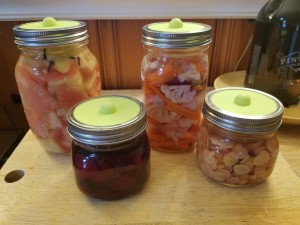
Ginger
Because the last batch spoiled I changed some things. 3% salt this time and a half-quart jar so I could pack it full of vegetable. I also added a slice of beet to tint it all pink… only very young ginger has that pink color you might know from sushi restaurants.
Watermelon Rind
I used this recipe I found with a quick search: Lacto Fermented Watermelon Rind Pickles. It’s a salt-by-volume one so I did a conversion. It calls for 1 tablespoon of salt in a quart jar. 1 quart is 946ml, 1 ml is 1 gram, 1 tablespoon is 17 grams so… 17/946 = 0.0179. The recipe is 1.8% salinity brine.
For my batch the vegetable plus water weighed in at 919 grams. I’m doing 2% for more crispiness and to ward against spoilage.
919 / 100 * 2 = 8.4 grams salt
We’re out of mustard seeds so I made stuff up.
- 1/8 tsp pepper flakes
- 1/2 tsp sliced ginger (snatched from the other jar)
- 1 clove garlic, smashed
Gardiniera and Beets
Nell wanted pickled cauliflower so I mixed them with some carrots. 2% salinity. I didn’t add any herbs or garlic b/c it’s been a long time since I did these and want to try their natural flavor. I did add a slice of beet. Later I might add a bit of stevia.
Beets are one of the easiest ferments around. I used a half-quart b/c we don’t eat them very quickly. Really good on salads.
2% salt.
Tip: Weighing and Measuring
The best way I’ve found is to first weigh the empty jar, making a note of the weight in grams.
Now stuff it. Use a tamper if you have one. For things like cucumbers, okra, and tomatoes, take care not to break them open. Fill the jar up to an inch from the top with filtered water.
Weigh the filled jar and subtract the weight of the empty jar. This is the weight of your batch. Divide by 100 then multiply by the % salinity you need.
Hold fingers over the top of the jar and pour the water into a bowl for mixing salt and spices.
Filed under: Uncategorized |
Comments (1)
June 1, 2019
Nell was wondering about this so I decided to give it a go. I scrounged around recipes online just to confirm that it’s no more complicated than vedge, salt, water, and time.
Fermented pickles are magic! Put your vegetables in salt water and lactobacilli will eat sugars to produce lactic acid. The acid and salt transform the vedge into tart, crispy pickles that last forever in the fridge.
Preparation
Choose “young” ginger without big thick chunks or lots of “nubs”, they are too woody. You want it fresh as possible, the skin on the ginger should look taught and waxy.
Use a good quality salt like sea salt. Kosher salt works too. Don’t use iodized salt, iodine is an antiseptic and will kill the helpful bacteria. Other table salt may have strange additives.
Don’t use tap water for the same reason, the chlorine will kill your helpful critters. Filtered water is A-OK or any flat bottled water.
Ignore recipes that specify the salt amount by volume. The salinity of your brine is the most important thing about pickling. A tablespoon of fine salt has more salt in it than a tablespoon of coarse salt. Metric measurements make it really easy to calculate the salinity of your brine.
This chart from Probiotic Jar is great!
Jar Your Ginger
- Peel your ginger.
- Slice it super thin with a mandolin
- Fill a mason jar up to 3″ from the top.
It’s OK if you don’t have enough to fill the jar.
- UPDATE: No, no it’s not. Whatever you’re pickling, pack the jar. Get a smaller jar if needed. Otherwise the lactobacillus won’t have enough sugar from the vegetables to acidify the brine.
- Add filtered/bottled water to fill the jar.
- Put a bowl on your scale and tare it.
- Empty the jar, water and all into the bowl.
- Calculate the grams of salt you need for 2% solution: vedge+water / 100 * 2
- Weigh out the salt and mix it with the vedge+water
- Pack it all back into the mason jar.
- Add your glass weights, plastic bag, or my favorite: QRP Pickle Cups
- Screw on an airlock lid.
I’ll taste it in about a week when primary fermentation is done and report back.
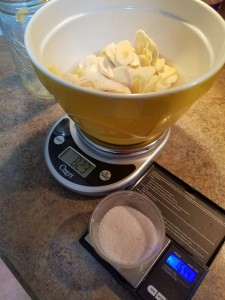
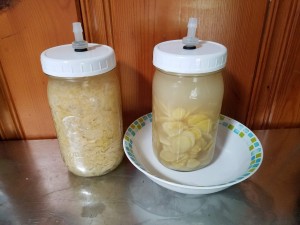
Ginger at right, oniony kraut at left.
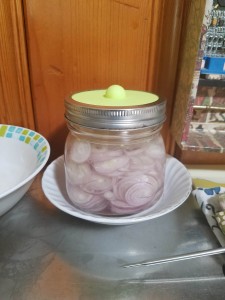
Started a batch of shallots too.
Filed under: Uncategorized |
Comments (1)
May 19, 2019
I’ve tried a lot of different things and decided I need to share what has worked best.
Food Retainer Aeration Cups
Forget about glass weights and springs, these are so simple and keep everything under the brine where it belongs with no floaties. During the first week, monitor the brine that overflows into the cup and pour enough back in to keep it all submerged.
Filed under: Uncategorized |
Comments (0)
August 20, 2017
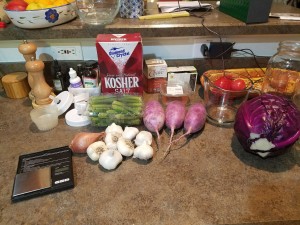 Some great ingredients at the store this weekend so I started a bunch of pickles.
Some great ingredients at the store this weekend so I started a bunch of pickles.
For the brines this is the salinity I used…
- Okra/carrot: 2.5%
- Garlic: 2% with a splash of strong 20% distilled vinegar
- daikon/carrot: 2%
A few days later… I have green garlic! I read about this a while ago and I _think_ the very acidic vinegar activated the sulphur in the skin of the garlic. So cool!
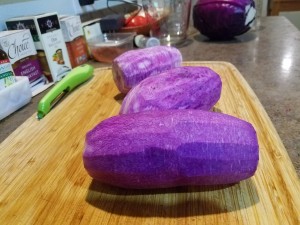
Purple daikon radish looks amazing when it’s peeled, really interesting textures.
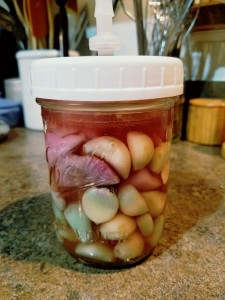
Filed under: Uncategorized |
Comments (0)
August 6, 2017
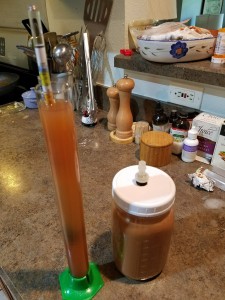 I’m starting to think that pumping up the ABV with honey is what causes oddball flavors in my concoctions. I’m going back to basics this time, no added sugar or honey.
I’m starting to think that pumping up the ABV with honey is what causes oddball flavors in my concoctions. I’m going back to basics this time, no added sugar or honey.
Wheatsville only had 2 gallons of apple juice so I also bought a gallon of Knudson’s cranberry pomegranate juice. Like most juice blends this is mostly apple juice so this should be a nice, simple hard cider. Total cost of ingredients for 3 gallons is $40.
For yeast I’m using reclaimed champagne and red wine yeasts. The red wine yeast is from my recent experimental batches so I’m sure it’s potent and active. The champagne was reclaimed back in March I think so I’m not sure of its potency.
- 2 gallons organic apple juice, $18
- 1 gallon organic Knudsons cranberry pomegranate juice, $12
- Yeast: Red Star Premier Rouge Wine Yeast and Red Star Premier Blanc (Pasteur) Chapagne Dry Wine, < 2$, reclaimed from prior batches.
- 1 1/2 teaspoon pectin enzyme
- 1 teaspoon LD Carlson Yeast Energizer
I kickstarted the yeast yesterday in a mixture of the same juices overnight. It’s bubbling away quite happily.
Brew Log
- 2017-08-13: Racked it to a carboy. The must is pretty tasty, seems promising. I’m hoping it turns out like the bottle of mixed cranberrry and regular cyser from Cyser Experiments.
Filed under: Uncategorized |
Comments (1)
July 3, 2017
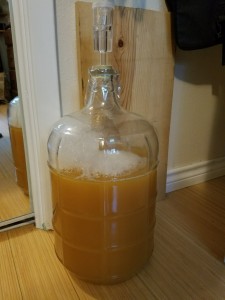
Racked to a carboy 2017-07-16. Fingers crossed!
Just seems wrong to have empty carboys sitting around. Brew time!
Ingredients
- 1 1/2 quarts mango puree from SoCo Homebrew
- 8 1/2 quarts apple juice
- 2 quarts Clover honey. 6.5 or 7 lbs?
- 1 1/2 teaspoon pectic enzyme
- 3/4 teaspoon DAP yeast energizer
- OG: 1.124, potential alcohol 14.96%
Yeast starter: White labs mead yeast, 1/4 teaspoon DAP, 3 cups apple juice (3/4 quart). This is reclaimed yeast from my mead batch. Not sure why I used mead yeast for this… :shrug:
Headed to 145° F then cooled slow-ish… didn’t feel like buying ice this time. Set the pot in cold water in the sink and changed it a couple times. Transferred to a primary fermentation bucket.
For secondary fermentation, I’m thinking of adding more mango. Chunks? Puree? I need to read about this.
Brew Log
- 2017-07-04: I was impatient last night and pitched my yeast before I proofed the starter. Also the must was warmer than the pros say it should be… about 70° F. Bah. Anyhoo, this AM it was bubbling away so it looks like it’s all good. I swirled it a bunch to oxygenate and de-gas so the yeast will multiply really well before switching to anaerobic mode.
- 2017-07-04: Later today our air conditioning broke down and was out for almost 2 days so the batch was subjected to 90° F temperatures. Not good! The primary fermentation was still in full swing, bubbling away during and after we got things cooled back down to 75° F. I’m hoping this didn’t stress the yeast and make it produce nasty flavors.
- 2017-07-09: Racked the batch into a clean bucket. Didn’t keep the yeast this time b/c of the heat ordeal it went through. I juiced 4 mangos and added it to the batch for secondary fermentation. The “juice” is more like thick pulp… mangoes are weird. I punched it down over the next few days but bubble activity ceased after only 2 days. Either the mangos didn’t add much sugar to keep the yeast busy or it was weakened by the heat up last week. I’ll rack it again next weekend and put it in glass to condition it for a month or so.
- 2017-07-16: Racked it. Cloudy as all get out. Just hoping the A/C failure didn’t ruin it.
- 2017-08-06: Racked it and tasted it… it has subtle mango notes but also something off… maybe yeast? Anyhoo, I’m going to add some gelatin to clarify it then rack it to bottles for a few weeks of conditioning.
- 2017-08-14: I never did add the gelatin. It’s starting to clear but still pretty cloudy.. ah! I didn’t add pectin enzyme when I added mango for the 2nd ferment. Not sure if that is common practice or not. I put it in the wine fridge to cold shock the yeast… get to flocculatin’ you critters! If that works I’ll go to bottles.
Filed under: Uncategorized |
Comments (0)
June 25, 2017
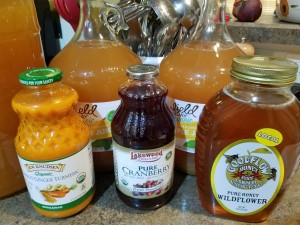 OK, I’ve had success with my other attempts… time to iterate!
OK, I’ve had success with my other attempts… time to iterate!
Each batch below also has 1/2 teaspoon DAP yeast nutrient, 1/2 teaspoon pectic enzyme, and enough apple juice to top off a 1-gallon jug.
I’m using a new yeast this time, a plain old RedStar Pasteur Red. It has a reputation for promoting fruity esters in wines and also some residual sweetness so it should be a good match for these. Also, it is very cheap. 😉
Carrot Ginger Turmeric
Who knows? Could be amazing. Gorgeous color!
- 16 oz honey
- 32 oz Knudsons Carrot Ginger Turmeric juice
- OSG: 1.085 @ 71 F, 11.1% potential ABV
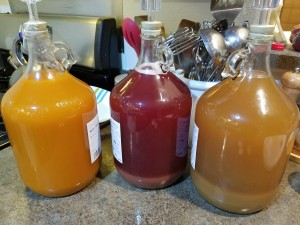 Cranberry
Cranberry
Apple, cranberry, and honey seem like a natural combination to me.
- 10 oz honey… whups, meant to do 1 lb but forgot.
- 32 oz Knudsons cranberry juice
- OSG: 1.076 @ 71 F, 10% potential ABV
Interestingly, this batch developed a layer of sediment at the bottom after only a couple hours on the countertop. I’m wondering if this is the pH level… I had planned to check this for all the batches but I forgot. I’ll do it when I rack them, assuming that primary fermentation is successful.
Plain Cyser
I want to see what changes when only the yeast is different.
- 16 oz honey
- OSG: 1.091 @ 71 F, 11.9% potential ABV
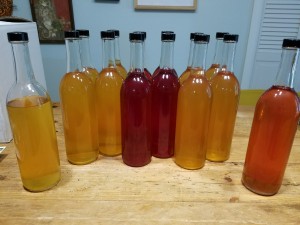 Notes / Log
Notes / Log
- 2017-06-25: Checked temperature today, all are at 69 F. Interestingly, the cranberry is actually about 1 degree warmer.
- 2017-07-03: Racked them all and added apple juice to top them off… say about a cup each. I haven’t ever done that before… I figured it will help pump up the apple flavors and and provide for a nice long secondary fermentation. Will reduce the ABV a bit since all these batches had added honey. The carrot and cranberry batches are fairly clear compared to the plain apple cyser. The cyser also had more foaming going on still where the other two had slowed way down. Heh, I forgot to check the pH on them, I wanted to do that to see if the cranberry was unusually acidic. Whups! I’ll check it at the next racking in a month or so.
- 2017-07-05: Our air conditioning went out for almost 2 days so all in-progress brewing was subjected to 90° F temperatures. I’m not too worried about these b/c the primary fermentation was already done.
- 2017-07-16: Bottled them all and put ’em in a box. So pretty! We tasted a bit of all three. Lynell did not like any of them. 🙂 I like the cranberry a lot, the carrot is interesting and tasty, and the plain old cyser is pretty boring. We’ll see what happens after a couple months or so. I bought some sulphate to keep them from getting fizzy but in the end I decided I still don’t wanna mess with sulphites. So these are all organic which means it’s healthy! Drink all you want! Right?
Filed under: Uncategorized |
Comments (0)
June 17, 2017
My buddy Greg sent me this recipe… time to venture into the unexplored world of vinegar pickles! I’m really interested to see the color change.
I used pickle weights to keep all the onion underneath the brine where it belongs.
http://www.thehungryhounds.com/blog/2015/4/25/quick-pickled-mexican-red-onions
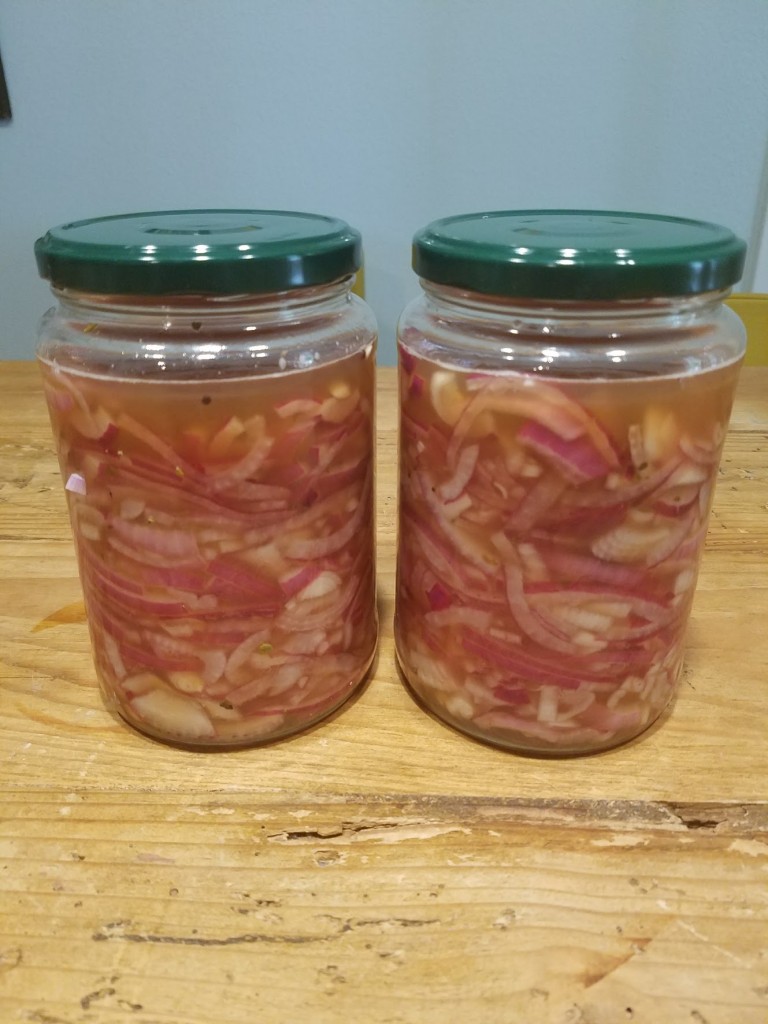
Filed under: Uncategorized |
Comments (0)
June 3, 2017
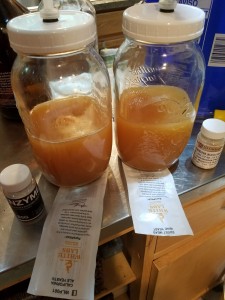 I’m trying a plain old mead so I can compare it with cyser, the cider/mead hybrid. Also trying a new yeast. I wanted to get it going really well before pitching into the must. Time to do my first yeast starter!
I’m trying a plain old mead so I can compare it with cyser, the cider/mead hybrid. Also trying a new yeast. I wanted to get it going really well before pitching into the must. Time to do my first yeast starter!
A yeast starter increases the amount of yeast you pitch so it gets going really vigorously. Happier, healthier yeast = full fermentation with fewer off flavors. I started to use http://www.meadmakr.com/batch-buildr/ to calculate how much honey to use but read that honey is nutrient deficient. Decided to do my first yeast starter with apple juice. I used this recipe from WYeast for the starter: 1qt apple juice, 1pack yeast, 1/4 tsp yeast energizer, 1/8 tsp pectin enzyme
I’m also starting an IPA tomorrow so I’ll do a yeast starter for that while I’m at it. I wonder if the apple juice starter will tweak it much?
Mead
OSG: 1.124
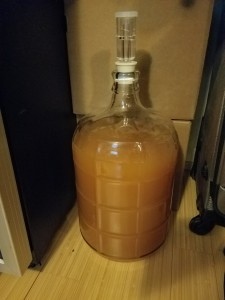 Yeast: White Labs’ Sweet Mead Wine
Yeast: White Labs’ Sweet Mead Wine
Honey doesn’t have all the nutrients needed for yeast (like nitrogen) so you have to add things. I don’t want to measure the SG a bunch to find the 1/3 sugar break so I’ll just use a simplified approximate schedule. Converting to 3 gallon batch amounts with (3 / 5 * 5 gal grams). Stirring and swirling is to de-gas the must, releasing CO2 from the liquid.
- Day 0 : stir and add 2.7 g of Fermaid K and DAP
- Day 1: swirl
- Day 2: stir and add 1.7g Fermaid K and 1.7g DAP
- Day 3: swirl
- Day 4:
stir and add 1.1g Fermaid-K and 1.1g DAP just swirled again
Brew Log
- 2017-06-11: Racked it. Quite cloudy, looks like this mead yeast from White Labs has low flocculation like the champagne yeast I’ve used. I’ll give it another week or two then chill it in the wine fridge for the yeast to drop out.
- 2017-06-25: Racked it. Still really cloudy! It’s been putting out slow bubbles too, seems like mead has a long tail of fermenting. I’m harvesting the yeast for use in a future batch, it’s in a honey jar with spring water to separate and clean it.
- 2017-07-04: Later today our air conditioning broke down and was out for almost 2 days so the batch was subjected to 90° F temperatures. Not good!
- 2017-07-09: The color is very dark now. There were white floaters on top and I was worried about mold. Many many people said don’t worry, just rack it from the bottom so that’s what I did.
- 2017-08-06: Racked gain. Tasted it, quite sweet! Maybe the fermentation didn’t go all the way in this one or perhaps it takes weeks and weeks to finish out. Anyhoo, no signs of white floaters so it seems all is well.
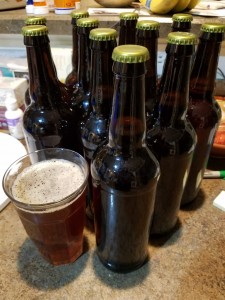 SoCo Town Lake IPA
SoCo Town Lake IPA
‘Nell wanted an IPA beer so I’m giving it a go. This is a recipe from SoCo Homebrew. The boil was complex, adding hops at 4 different times. Now though it’s just waiting and watch the bucket, 2-3 weeks until it’s ready.
OSG: 1.055
Yeast: White Labs’ California Ale
Brew Log
- 2017-06-25: Bottled it! A week or so to carbonate and it will be ready.
- 2017-08-14: Lynell loves this beer, says it’s better than anything she’s bought in the store. I’ll have to try it again sometime.
Filed under: Uncategorized |
Comments (2)
May 20, 2017
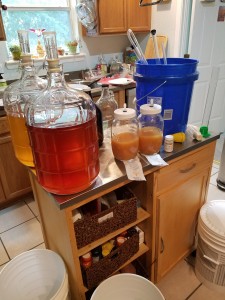 Ingedients
Ingedients
- 2 gallons apple juice
- 2 quarts blueberry pomegranate juice (sweetened with apple)
- 2 lb honey with enough water to make 2 quarts.
- 1 additional quart water to compensate for racking loss.
- 1 ½ tsp yeast nutrient
- 1 ½ tsp pectin enzyme
- Yeast: Red Star Premier Blanc (champagne)
Notes
- OSG: 1.074. If FSG is 0.99 then 11.03% ABV
- 2015-05-28: FSG: 0.998. ABV: 9.98%
Log
- Stir each day for 4 days to aerate the yeast during aerobic phase.
- 2017-05-22 Stirred with lid off. Heh, didn’t keep up with my plan.
- Has been very low activity for this entire time, wondering if it’s a busted batch. Asked my buddy David di Blasio, he says sometimes the yeast will chew up all the sugar super fast. Suggested to measure with hydrometer to check if primary fermentation is done. I think I have been letting primary fermentation continue too long. This source says to rack it at 1.005 SG, I’ve been waiting until activity stops, usually < 1.0 SG.
- 2015-05-28: Very low gas activity.
- I bought a wine thief for easier SG measurement. Turns out it’s too tall for these 3 gallon batches, had to use a baster to fill up the rest of the tube so I could float the hydrometer.
- FG = 0.998. ABV: 9.98% – slightly egg-ey smell. Racking it.
- Tasting notes…
- Nell: Can’t describe it.
- Morg: Very neutral, hardly any flavor to describe. Some apple notes in the back of my tongue. Maybe this one will be a good candidate for flavoring. Using the blueberry pomegranate juice seems pointless, can’t tell if there is any difference in taste from plain cider sweetened with honey.
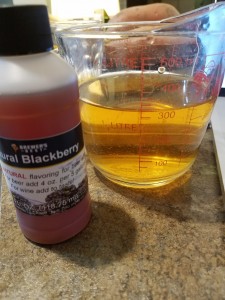 2015-06-03: Racked to two 1 gallon jugs.
2015-06-03: Racked to two 1 gallon jugs.
- Tasting notes…
- Nell: Aack, there’s some kind of sharp, off flavor, hits me right in the mouth.
- Morg: Still very neutral to me. Drinkable but not much flavor overall.
- Going to try adding blackberry extract to 300 ml gradually and tasting along the way.
- 0.1 ml – 0.5 ml – No taste
- 0.8 ml, 1 drop stevia – I like the little bit of sweet. Still can’t taste the blackberry.
- 1.0 ml, 1 drop stevia. I did a comparison with a sample of the unflavored bit. This is definitely better. Going to stop adding stuff b/c right now it’s competing with that off flavor… now I can tell what Lynell meant. There is a heavy sharp flavor on the tongue. Folks say to let the brew sit for a couple months to mellow out any off flavors. I don’t want the flavoring to overpower it.
- 1 gallon is 3785 ml. So… 1/300 * 3785 = 12.6 ml of flavoring, 12 drops stevia.
Filed under: Uncategorized |
Comments (0)

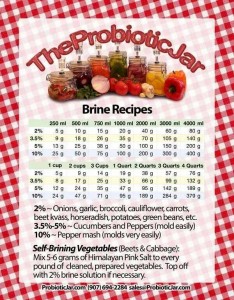



 Some great ingredients at the store this weekend so I started a bunch of pickles.
Some great ingredients at the store this weekend so I started a bunch of pickles.

 I’m starting to think that pumping up the ABV with honey is what causes oddball flavors in my concoctions. I’m going back to basics this time, no added sugar or honey.
I’m starting to think that pumping up the ABV with honey is what causes oddball flavors in my concoctions. I’m going back to basics this time, no added sugar or honey.
 OK, I’ve had success with my other attempts… time to iterate!
OK, I’ve had success with my other attempts… time to iterate! Cranberry
Cranberry Notes / Log
Notes / Log
 I’m trying a plain old mead so I can compare it with
I’m trying a plain old mead so I can compare it with  Yeast: White Labs’ Sweet Mead Wine
Yeast: White Labs’ Sweet Mead Wine SoCo Town Lake IPA
SoCo Town Lake IPA Ingedients
Ingedients 2015-06-03: Racked to two 1 gallon jugs.
2015-06-03: Racked to two 1 gallon jugs.